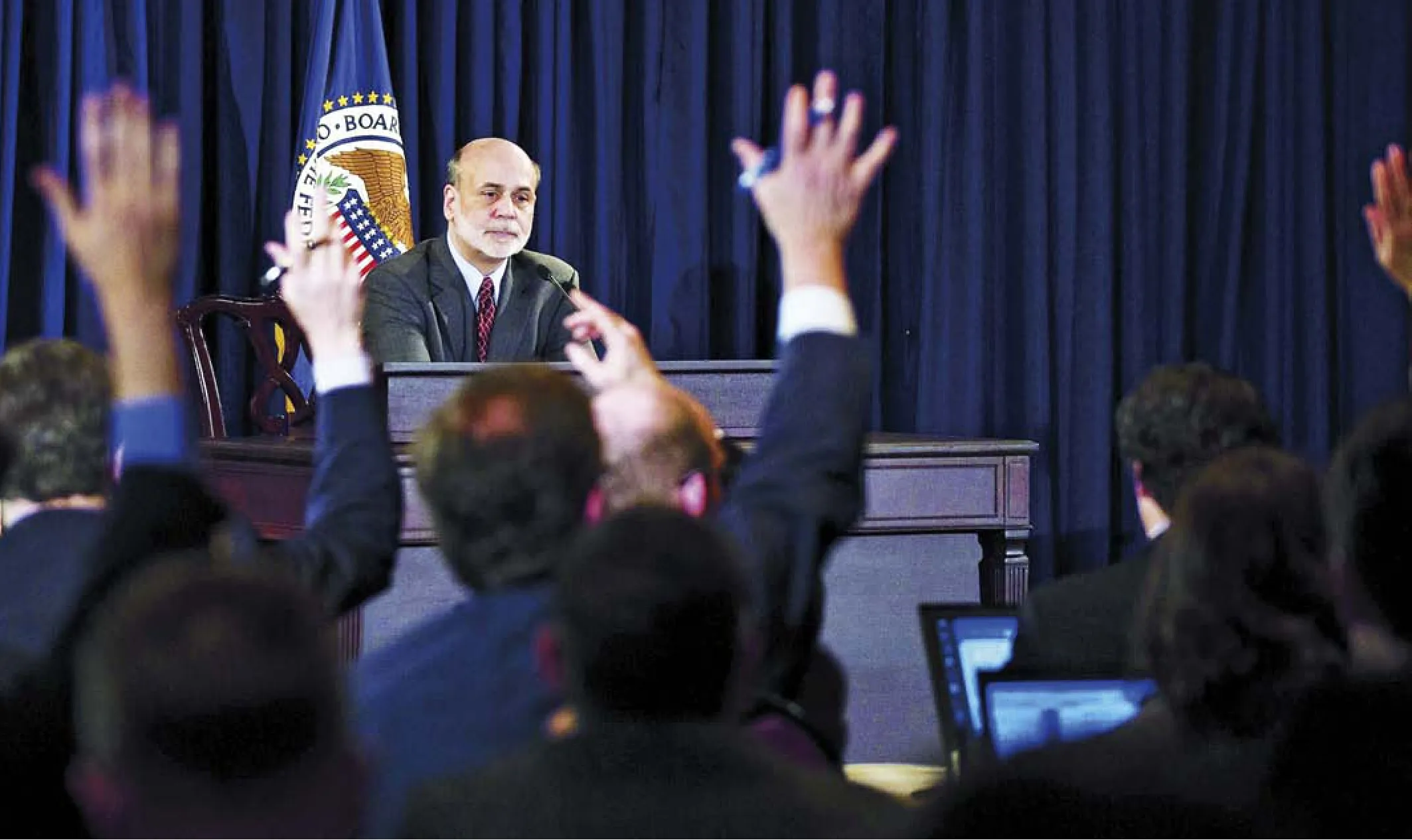Debt Dilemma
2011-10-14JAMESA.DORN
Debt Dilemma
The United States faces tough choices of running deficits or limiting government

Now that the U.S. Federal Government has reached its legal debt limit of$14.3 trillion, stark choices lie ahead.Current spending growth is unsustainable. Indeed,the Government Accountability Office estimates entitlement spending on Social Security, Medicare and Medicaid alone will amount to more than 20 percent of GDP by 2080, if current policies are unchanged. That level of spending would absorb 100 percent of federal revenues, assuming the federal tax share of GDP increased from its average level of 18 percent to 20 percent.
In the next decade, federal budget de ficits could add another $10 trillion to public debt. By 2035, total federal spending could reach 34 percent of GDP, and climb to 42 percent by mid-century. As recently as 2001,federal spending was 18 percent of GDP, but rose to nearly 25 percent in 2009, and has stayed at that level.
The rapid increase in federal spending—from $1.9 trillion in 2001 to $3.8 trillion today—is enlarging the size and scope of government and putting a drag on long-term economic growth. Total government spending at all levels now exceeds 40 percent of GDP. Studies have shown that, once government spending reaches about 20 percent of GDP, additional spending can slow economic growth and significantly decrease future living standards. Because of compounding,a small decline in the growth rate can have a large effect on the level of per-capita real income over time.
Resources shifted into government typically have lower productivity, are wasted,and require higher taxes—now or in the future. Those taxes distort market prices and cause what economists call an “excess burden” or a “deadweight loss”—that is,a net loss of value from limiting mutually beneficial exchanges. The Congressional Budget Office estimates each extra dollar of revenue raised costs the U.S. economy as much as $1.60. Other estimates are even higher. Moreover, as tax rates rise,distortions multiply and deadweight losses mount even faster.
Excessive government spending and high tax rates reduce economic freedom and thus the range of choices open to individuals.When government runs large deficits and adds to the national debt, private investment can be crowded out if interest rates rise. That process has been delayed because China and other foreign lenders have provided the U.S.Government with cheap credit while the U.S.Federal Reserve has artificially lowered interest rates by acquiring massive amounts of Treasury securities. China is now the largest foreign holder of U.S. Treasuries, with an estimated $1.15 trillion invested, while the Federal Reserve holds $1.37 trillion on its balance sheet.

PUBLIC OUTCRY: U.S. diplomats rally outside the State Department in Washington, D.C. on April 8 in support of federal workers against a possible government shutdown triggered by a budget impasse
The Federal Reserve’s second round of quantitative easing that began earlier this year will have added $600 billion in Treasury securities to the Fed’s books by the time the program ends in June. When the Fed buys government debt, it creates bank reserves,expanding the monetary base. Since the onset of the recession in 2008, the Fed has vastly expanded its balance sheet from $907 billion in September 2008 to $2.7 trillion today. In the process, the monetary base has increased from $848 billion in January 2008 to $2.6 trillion today.
The risk is large amounts of excess reserves banks are holding at the Fed will enter into the money fl ow as the economy recovers and pro fi t opportunities increase. The Fed will need to have a credible exit strategy to dampen inflationary expectations. By holding interest rates too low for too long and encouraging risky investments, the Fed may be fueling asset bubbles in bond and stock markets and in commodities.When interest rates rise, as they must, a fi nancial panic could occur.
Monetizing the U.S. debt and engaging in stimulus spending are short-term palliatives, not solutions to promoting long-run growth. The Fed has misallocated credit and pretended that monetary stimulus creates jobs.
The Treasury Department is financing trillion-dollar deficits with short-term debt, at low interest rates. However, when interest rates return to normal, it will be confronted with having to refinance nearly 60 percent of its debt at higher rates, which will put a big strain on the budget.
Today, the gross federal debt is approaching 100 percent of GDP. In addition, unfunded liabilities of Social Security and Medicare total more than$100 trillion. Studies by leading economists Kenneth Rogoff and Carmen Reinhart have shown that when sovereign debt exceeds 90 percent of GDP, real growth tends to slow.Politicians are by nature short-sighted and look to the next election. Investors have a longer vision and sell assets they expect to lose value because of current policy. It is not surprising that Standard &Poor’s downgraded its outlook for U.S. sovereign debt to negative, given the intransigence of Congress to make fundamental changes to entitlement programsand to slow the growth of overall spending.

ECONOMIC IMPETUS: Ben Bernanke, Chairman of the U.S. Federal Reserve, speaks at a press conference in Washington, D.C.on April 27. The Fed said it will maintain quantitative easing in a bid to stimulate economic recovery
The general election next year will be a referendum on the role of government. The debate between those who favor limited government and those who favor“progressive” government has never been stronger. If market liberals prevail, government spending will return to a much lower percentage of GDP and marginal tax rates will fall. Economic growth will increase and be sustained. If modern liberals or progressives prevail, taxes will rise, spending will moderate, but government will grow as entitlements crowd out private saving and investment.
China, and others holding U.S. sovereign debt, will suffer huge losses if the United States cannot get its fi scal house in order—and return to constitutionally limited government. Moreover, if the Federal Reserve delays its exit strategy too long,in fl ationary expectations could further depreciate the foreign exchange value of the dollar, leading to even higher commodity prices and to general inflation. The real burden of the U.S. debt then would fall on the backs of creditors who get paid back in cheaper dollars. In fl ation would also lead to higher interest rates and lower bond prices, inflicting capital losses on bond holders.
Some argue China has been funding the growth of the U.S. Government, not private enterprise. If the Chinese people had the freedom to hold dollars and invest them in the U.S. private sector, both China and the United States would bene fi t. By undervaluing the yuan against the dollar, China has accumulated more than $3 trillion in foreign exchange reserves, with a substantial amount invested in U.S. government securities.Ending exchange and capital controls would allow Chinese savings to be more ef fi ciently allocated and allow the People’s Bank of China to focus on achieving long-run price stability. Financial repression would end and domestic consumption would increase,putting China on a sustainable path for economic growth.
In the next several months, the U.S.Congress must decide on how to avoid defaulting on the U.S. debt. If spending limits are enforced and entitlements are tackled,capital markets will react favorably. But, no one will be sure of the future state of spending and taxes until after the election next November. Even then, in a democracy, the fi scal future will remain uncertain unless the Constitution provides guidance in limiting the size and scope of government.
For most of America’s history, adherence to the framers’ “Constitution of Liberty” did limit government spending, and the private sector flourished. Whether that ethos of liberty returns will determine the future path of U.S. fi scal and monetary policies. China should be watching closely.
(Viewpoints in this article do not necessarily represent those of Beijing Review)
If the Federal Reserve delays its exit strategy too long, inflationary expectations could further depreciate the foreign exchange value of the dollar. The real burden of the U.S. debt then would fall on the backs of creditors who get paid back in cheaper dollars
The author is vice president for academic affairs with the Washington, D.C.-based Cato Institute and editor of theCato Journal
